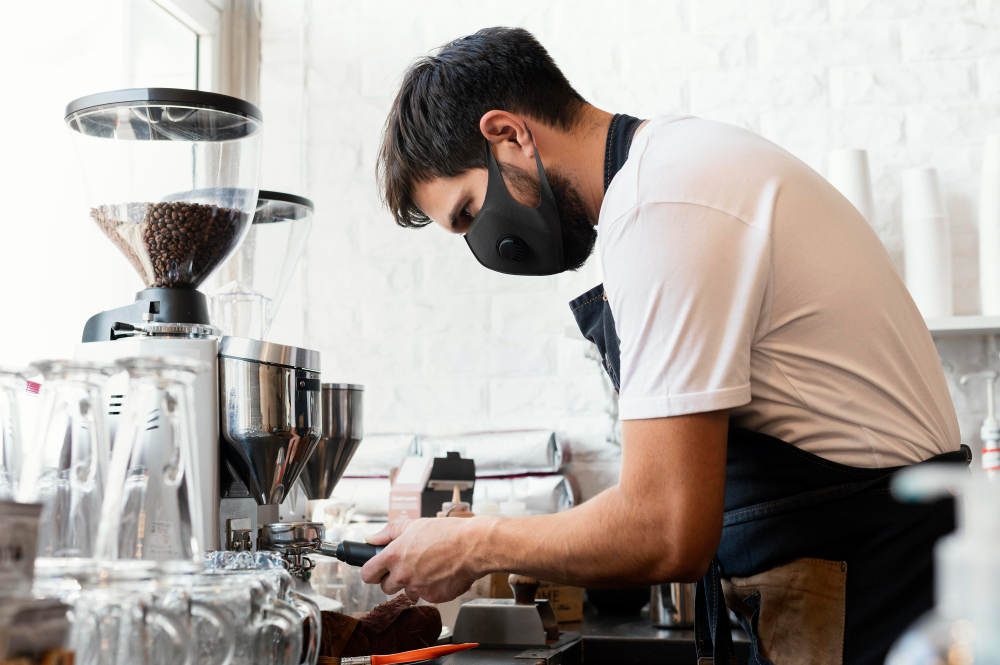The pour-over method of making coffee is a manual brewing technique that involves pouring hot water over coffee grounds in a filter. This process allows for more control over the brewing variables such as water temperature, flow rate, and extraction time, resulting in a more customizable and potentially more flavorful cup of coffee.
The pour-over coffee brewing method has gained popularity in recent years due to its ability to produce a clean, flavorful cup of coffee.
Here is a brief history of pour-over coffee:
Origins: Pour-over coffee has been around for a long time, with roots that can be traced back to early coffee brewing methods in Europe and Asia. The basic concept of pouring hot water over coffee grounds to extract flavor has been a part of coffee culture for centuries.
Melitta Bentz: The pour-over method as we know it today was popularized by a German housewife named Melitta Bentz in 1908. Frustrated with the bitterness and coffee grounds in her brewed coffee, Melitta decided to experiment with a new brewing method. She punched holes in a brass pot and lined it with blotting paper from her son’s school notebook. She then placed coffee grounds in the paper-lined pot and poured hot water over them. This simple yet effective method led to the creation of the iconic Melitta coffee filter and the pour-over brewing process we use today.
Rise in Popularity: While drip coffee machines dominated the coffee market for many years, the pour-over method experienced a resurgence in the specialty coffee scene in the late 20th century and continues to be a favorite among coffee enthusiasts and baristas alike. The control and precision it offers in brewing allows for a customizable cup of coffee that highlights the unique flavors of different coffee beans.
Equipment and Techniques: Pour-over coffee typically involves a cone-shaped dripper (such as the Hario V60 or Chemex), a paper or metal filter, freshly ground coffee beans, and hot water at the optimal temperature (around 195-205°F or 90-96°C). The technique involves pouring water in a slow, steady stream over the coffee grounds in a circular motion, allowing the water to fully saturate the grounds and extract flavors evenly.
Ritual and Craftsmanship: One of the appeals of pour-over coffee is the ritualistic aspect of the brewing process. It requires attention to detail, precision, and patience, making it a favorite among coffee connoisseurs who appreciate the craftsmanship involved in making a perfect cup of coffee.
Overall, the history of pour-over coffee is a story of innovation, simplicity, and a quest for the perfect cup of coffee that continues to evolve and inspire coffee lovers around the world.
Here’s a general guide on how to make pour-over coffee:
What You’ll Need:
Pour-over dripper (e.g., Hario V60, Chemex, Kalita Wave)
Paper filter specific to your dripper
Freshly ground coffee
Kettle
Scale
Timer
Mug or server
Steps to Make Pour-over Coffee:
Step One:
Boil Water: Bring water to a boil and let it cool for about 30 seconds to 1 minute (aim for around 200°F or 93°C).
Step Two:
Grind Coffee: Grind your coffee beans to a medium-fine consistency, similar to sea salt. Use about 1:15 coffee to water ratio (e.g., 30g coffee to 450g water).
Step Three:
Rinse Filter: Place the paper filter in the dripper and rinse it with hot water to remove any paper taste while preheating the dripper and your mug/server.
Step Four:
Add Coffee: Add the ground coffee to the rinsed filter and give it a gentle shake to settle the grounds evenly.
Step Five:
Bloom: Start your timer and pour just enough water (about twice the weight of the coffee grounds) to saturate them. Allow the coffee to bloom for about 30 seconds as it releases trapped gases.
Step Six:
Pour Slowly: Starting from the center, pour water in a slow, steady spiral motion over the coffee grounds. Avoid pouring directly onto the filter to prevent channeling.
Step Seven:
Maintain Water Level: Keep the water level consistent by pouring in small increments, allowing the coffee to drip through the grounds evenly.
Step Eight:
Finish: Once you’ve reached the desired coffee weight, give the dripper a gentle swirl to level the grounds and allow the last drips to fall through.
Step Nine:
Enjoy: Discard the filter and grounds, then pour your freshly brewed coffee into your mug or server. Take a moment to savor the flavors and aroma!
Experiment with different coffee beans, grind sizes, water temperatures, and pouring techniques to find the perfect brew that suits your taste preferences. Happy brewing!

